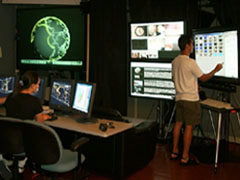Impact of Display-rich Environments for Enhancing Task Parallelism and Group Awareness in Advanced Collaborative Environments
June 24th, 2003
Categories: Tele-Immersion

Authors
Leigh, J., Johnson, A., Park, K.S., Renambot, L.About
An Amplified Collaboration Environment (ACE) is a distributed extension of a war room in which a group of people co-locate for several days to months to solve a problem together. A war room may contain numerous whiteboards, flipcharts and corkboards on which the group members post information throughout the course of the meeting. These meeting artifacts are kept persistent during the course of the campaign so that group members can refer back to them from time to time. Prior research in war rooms has shown that in some cases productivity can be enhanced far beyond the corporate average. The goal of an ACE is to provide a future generation collaboratorium by augmenting the traditional concept of the war room with technologies that permit distributed teams to bring in its problem solving benefits.
The Continuum is an ACE specifically targeted for supporting collaborative scientific investigation. The Continuum uses four main technologies: an Access Grid (AG) node to support group-to-group communication; a passive stereoscopic display for sharing immersive views of 3D content; a scalable LCD tiled display that provides shared views of text documents, web pages, spreadsheets, graphs and chart, and high-resolution scientific visualizations; a shared plasma touch screen that supports collaborative annotation; and wireless laptops, PDAs and tablet PCs for remote access to the numerous displays. The Continuum Project is currently developing the hardware and software technology and human factors research, for supporting an ACE.
We are currently trying to understand how the Continuum’s tiled displays can be used in enhancing task parallelism and group awareness between distributed sites during intensive collaborative work. Tiled displays are often used to project a single, extremely large, high-resolution visualization. It is our belief however, that for collaboration, a better way to use a tiled display is as a large distributed “corkboard” which allows meeting participants to “pin up” informational artifacts for all to see. From our prior experience in developing teleimmersive environments, we have found that there are benefits to be gained when participants do not see the same view during collaboration. By being able to tailor their individual views, collaborators can work in parallel on a problem. We observed that, within a real-time tele-immersive scientific data analysis exercise, participants tended to work independently for the most part and then synchronize from time to time to share and discuss findings. We also observed that participants needed more continuous feedback of the partner’s action or intention to maintain group awareness, such as signaling or illustrating certain actions to the partner. Over the past year, we have developed and examined a set of iterative design studies to understand how to support realtime collaborative information visualization. The study involves placing collaborators in two separate sites and asking them to perform a variety of information discovery and knowledge crystallization tasks using Continuum. In this iterative study we want to understand how the technology configuration affects the collaboration pattern and/or group performance between participants. The goal of this study is to explore the design issues for Continuum to enhance cooperative work in ACEs.
Resources
Citation
Leigh, J., Johnson, A., Park, K.S., Renambot, L., Impact of Display-rich Environments for Enhancing Task Parallelism and Group Awareness in Advanced Collaborative Environments, Proceedings of The Global Grid Forum, GGF8 : Workshop on Advanced Collaboration Environments, Seattle, WA, June 24th, 2003.